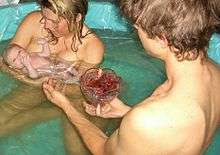Water birth

Water birth is childbirth that occurs in water. Proponents believe water birth results in a more relaxed, less painful experience that promotes a midwife-led model of care.[1] Critics argue that the safety of water birth has not been scientifically proven and that a wide range of adverse neonatal outcomes have been documented,[2] including increased mother or child infections and the possibility of infant drowning. A 2009 Cochrane Review of water immersion in the first stages of labor found evidence of fewer epidurals and few adverse effects but insufficient information regarding giving birth in water.[1] Parent, child, and birthing organizations have produced statements both supporting and criticizing water birthing.
Benefits
It has been widely reported that immersion during the first stage of childbirth reduces the pain of labor. Various theories as to the reason for the reduction of pain include the suggestions that the mother is better able to assume a comfortable position and that the warmth of the water may produce a sedative effect; immersion has been shown to decrease the release of several stress and anxiety related hormones. A 2014 review comparing immersion during the first stage of labor to regional analgesia found that "immersion during the labor is convenient, comfortable, and has no side effects. No anesthesiologist is required, and there is no risk of trauma or the complications of anesthesia. Thus, water immersion during the labor is a relatively ideal method for providing analgesia during labor."[3]
Water birth offers perineal support for a birthing mother, which decreases the risk of tearing and reduces the use of episiotomy.[4] A Cochrane Review found that immersion during the first stage of childbirth reduces the use of epidurals, though it could not reach any other conclusions for other stages of labor or other outcomes and did not have enough information to make any conclusions on full water birth. It did not find evidence of increased adverse effects for immersion during the first stages of labor.[1]
A 2014 review reported that it has been found that water immersion during the first stage of labor can reduce the length of the first stage, reduce labor pain, and the use of epidural/spinal analgesia. It is also associated with a lower rate of cesarean delivery and stress urinary incontinence symptoms 42 days after delivery. The review reported that immersion during labor did not appear to increase the rate of infections for the mother or the baby, and APGAR scores for the baby were similar to that of conventional births. [3]
Risks and concerns
The British Royal College of Obstetricians and Gynaecologists and the Royal College of Midwives issued a joint statement supporting water birth for healthy women with uncomplicated pregnancies but does not recommend it in cases of complications.[5]
In a 2005 commentary, the Committee on Fetus and Newborn of the American Academy of Pediatrics (AAP) released an analysis of the scientific literature regarding underwater births. The Committee noted several positive studies for underwater birth but went on to criticize them for lacking proper scientific controls, a significant number of infant deaths and diseases, and the general lack of information to support the use of water births. The paper concluded:[6]
The safety and efficacy of underwater birth for the newborn has not been established. There is no convincing evidence of benefit to the neonate but some concern for serious harm. Therefore, underwater birth should be considered an experimental procedure that should not be performed except within the context of an appropriately designed RCT after informed parental consent.
The AAP received numerous letters in response to the statement, many claiming passionately that water birth had strong benefits and minimal risks for both parents and children and criticizing the AAP for failing to publish positive studies about the practice. In response, an author of the statement noted that the claims made were unsubstantiated and based purely on anecdotal evidence, with no randomized controlled trials (RCTs) that would allow an evidence-based assessment of the safety and benefits of water births. The author concluded by urging for proponents to support such a trial so that the question could be answered. The editor of the journal Pediatrics, where the commentary was published, noted that no such trials had ever been submitted to the journal, which had a policy against publishing articles that are not based on scientific evidence. The reply concluded that "I have not received any science-based commentaries from the groups that you cite in your letter. We cannot publish every letter, based on opinions only, that we receive."[7]
References
- 1 2 3 Cluett, E. R.; Burns, E. (2009). Cluett, Elizabeth R, ed. "Immersion in water in labour and birth". The Cochrane Library (2): CD000111. doi:10.1002/14651858.CD000111.pub3. PMID 19370552.
- ↑ Schroeter, K. (2004). "Water Births: A Naked Emperor". Pediatrics. 114 (3): 855–858. doi:10.1542/peds.2004-0145. PMID 15342864.
- 1 2 Yinglin Liu; Yukun Liu; Xiuzhi Huang; Chuying Du; Jing Peng; Peixian Huang; Jianping Zhang. "A comparison of maternal and neonatal outcomes between water immersion during labor and conventional labor and delivery". Research article. BioMed Central. Retrieved 20 January 2015.
- ↑ Garland, D (2000). Waterbirth: An Attitude to Care. Elsevier. ISBN 0750652020.
- ↑ "Immersion in water during labour and birth" (pdf). Royal College of Midwives/Royal College of Obstetricians and Gynaecologists. 2006. Retrieved 2012-08-29.
- ↑ Committee On Fetus Newborn; Blackmon, D. G.; Adamkin, L. R.; Bell, D. H.; Denson, E. F.; Engle, S. E.; Martin, W. A.; Stark, G. I.; Barrington, A. R.; Raju, K. J.; Riley, T. N.; Tomashek, L.; Wallman, K. M.; Couto, C.; Couto, J. (2005). "Underwater Births". Pediatrics. 115 (5): 1413–1414. doi:10.1542/peds.2004-1738. PMID 15867054.
- ↑ Hess, S. (2005). "Strong Opinions Versus Science in Water-Birth Controversy". Pediatrics. 116 (2): 522–523; author 523 523. doi:10.1542/peds.2005-1334. PMID 16061620.